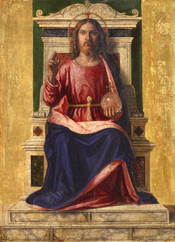
Back Estado intermedio (cristianismo) Spanish Keadaan antara ID 中間の状態 Japanese 음간 Korean Estado intermediário Portuguese
| Part of a series on |
| Salvation in Christianity |
|---|
 |
| General concepts |
| Particular concepts |
| Punishment |
| Reward |
In some forms of Christianity, the intermediate state or interim state is a person's existence between death and the universal resurrection. In addition, there are beliefs in a particular judgment right after death and a general judgment or last judgment after the resurrection. It bears resemblance to the Barzakh in Islam.
Early Christians looked for an imminent end of the world and many of them had little interest in an interim state between death and resurrection. The Eastern Church admits of such an intermediate state, but refrained from defining it, so as not to blur the distinction between the alternative definitive fates of Heaven and Hell. The Western Church goes differently by defining the intermediate state, with evidence from as far back as the Passion of Saint Perpetua, Saint Felicitas, and their Companions (203) of the belief that sins can be purged by suffering in an afterlife, and that purgation can be expedited by the intercession of the living.
Those in the intermediate state have traditionally been the beneficiaries of prayers, such as requiem masses. In the East, the saved are said to rest in light while the wicked are confined in darkness; the dead can be assisted by prayer.[1] Prayers are said to benefit those in Hades, even those who were pagans.[2]
In the West, Augustine described prayer as useful for those in communion with the church, and implied that every soul's ultimate fate is determined at death.[2] Such prayer came to be restricted to souls in Purgatory,[2] which idea has "ancient roots" and is demonstrated in early Church writings.[3]
The Roman Catholic Church offers indulgences for those in purgatory, which evolved out of the earlier practice of canonical remissions.[4] Others, such as Lutherans and Anglicans, affirmed prayer for the dead.[5][6] Nonconformist Protestants, such as Baptists, largely ceased praying for the dead. Protestants universally reject the Roman Catholic doctrine of purgatory, while affirming the existence of an intermediate state, usually termed Hades.[7][8][9] John Calvin depicted the righteous dead as resting in bliss.[10]
- ^ Oxford Dictionary of the Christian Church (Oxford University Press 2005 ISBN 978-0-19-280290-3), article purgatory
- ^ a b c "Dead, prayer for the." Cross, F. L., ed. The Oxford dictionary of the Christian church. New York: Oxford University Press. 2005
- ^ Zaleski, Carol, Purgatory, Encyclopædia Britannica, retrieved April 13, 2016
- ^ "Indulgences." Cross, F. L., ed. The Oxford dictionary of the Christian church. New York: Oxford University Press. 2005
- ^ Tappert, Theodore Gerhardt (1 January 1959). The Book of Concord: The Confessions of the Evangelical Lutheran Church. Fortress Press. p. 267. ISBN 9781451418941.
We know that the ancients spoke of prayer for the dead. We do not forbid this, but rather we reject the transfer of the Lord's Supper to the dead ex opere operato. The ancients do not support the opponents' idea of the transfer ex opere operato.
- ^ Quivik, Melinda A. (1 July 2005). A Christian Funeral: Witness to the Resurrection. Augsburg Books. p. 55. ISBN 9781451414547.
In "The Babylonian Captivity of the Church," Luther called upon pastors to pray for the dead without giving masses for the dead. Such prayers are approved in the Lutheran confessional writings. Philipp Melanchthon's "Apology" specifically held out the possibility of such prayer: "We know that the ancients spoke of prayer for the dead. We do not prohibit this, but we do reject the transfer, ex opere operato, of the Lord's Supper to the dead" (Kolb and Wengert, pp. 275-76). Such prayers can be found in past Lutheran practice. Evidence exists that such prayers were offered up in some Lutheran orders of the sixteenth century. Philip Pfatteicher's commentary on LBW explained that the dead have not left the body of Christ by dying but remain members of the body (pp.475-82).
- ^ Heatwole, Lewis James (15 September 2022). Mennonite Handbook of Information.
ARTICLE XVIL OF THE INTERMEDIATE STATE: We believe that in the interval between death and reseurrection, the righteous will be with Christ in a state of conscious bliss and comfort, but that the wicked will be in a place of torment, in a state of conscious suffering and despair. Lu. 16:19-31; 23:43; Phil. 1:23; II Cor. 5:1-8; I Thes. 5:10; II Pet. 2:9 (R.V.). ARTICLE XVII. OF THE FINAL STATE: We believe that hell is the place of torment, prepared for the devil and his angels, where with them the wicked will suffer the vengeance of eternal fire forever and ever and that heaven is the final abode of the righteous, where they will dwell in the fullness of joy forever and ever. Matt. 25:41, 46; Jude 7; Rev. 14:8-11; 20:10, 15; II Cor. 5:21; Rev. 21:3-8; 22:1-5.
- ^ Yrigoyen, Charles Jr.; Warrick, Susan E. (2005). Historical Dictionary of Methodism. Scarecrow Press. p. 107. ISBN 978-0810865464.
Considering the question of death and the intermediate state, John Wesley affirmed the immortality of the soul (as well as the future resurrection of the body), denied the reality of purgatory, and made a distinction between hell (the receptacle of the damned) and hades (the receptacle of all separate spirits), and also between paradise (the antechamber of heaven) and heaven itself.
- ^ Holden, George (1855). The Anglican Catechist: Manual of Instruction Preparatory to Confirmation. London: Joseph Masters. p. 40.
We are further taught by it that there is an intermediate state between death and the resurrection, in which the soul does not sleep in unconsciousness, but exists in happiness or misery till the resurrection, when it shall be reunited to the body and receive its final reward.
- ^ John Calvin, Psychopannychia Archived 2009-01-21 at the Wayback Machine, @ lgmarshall.org